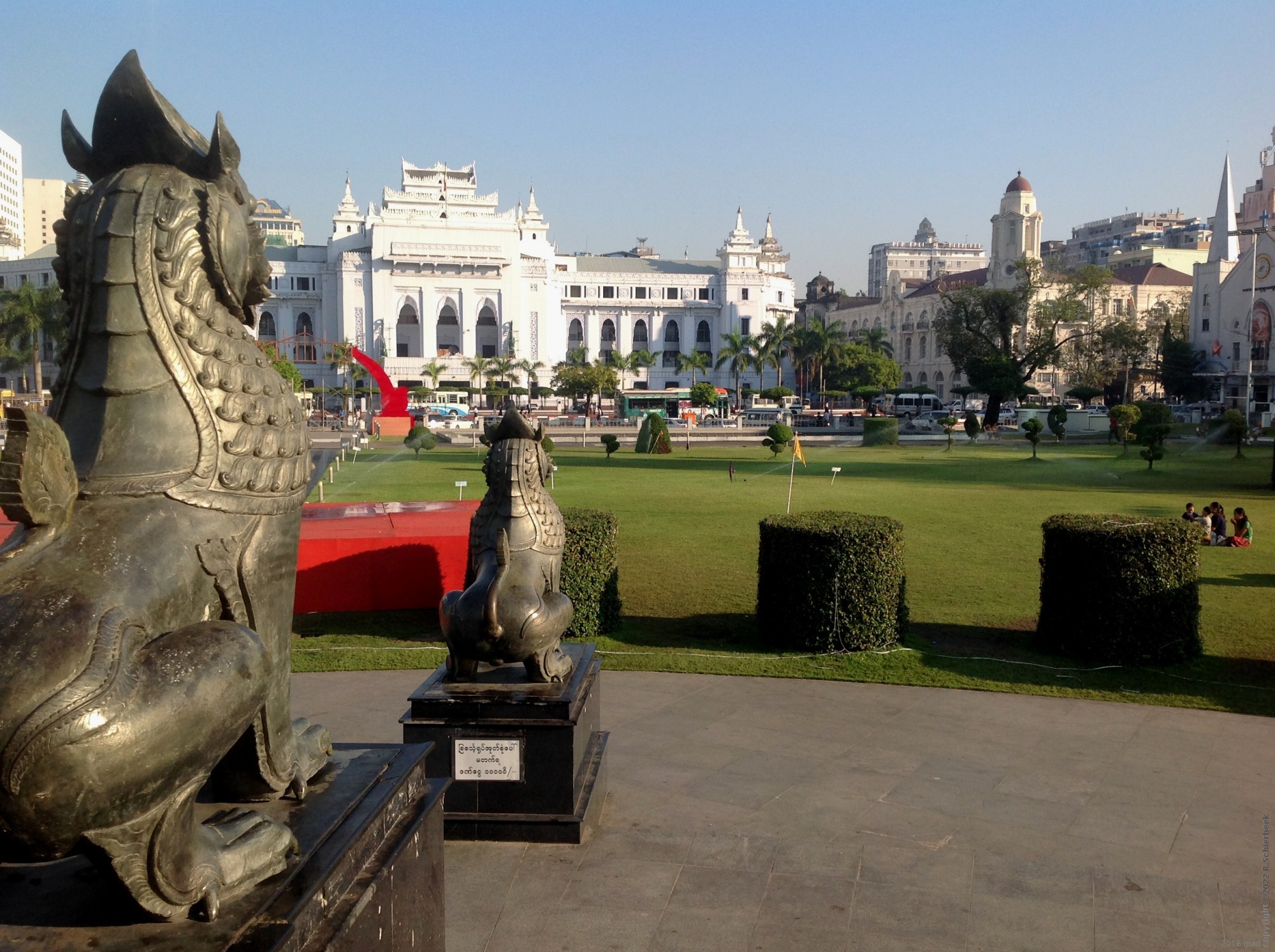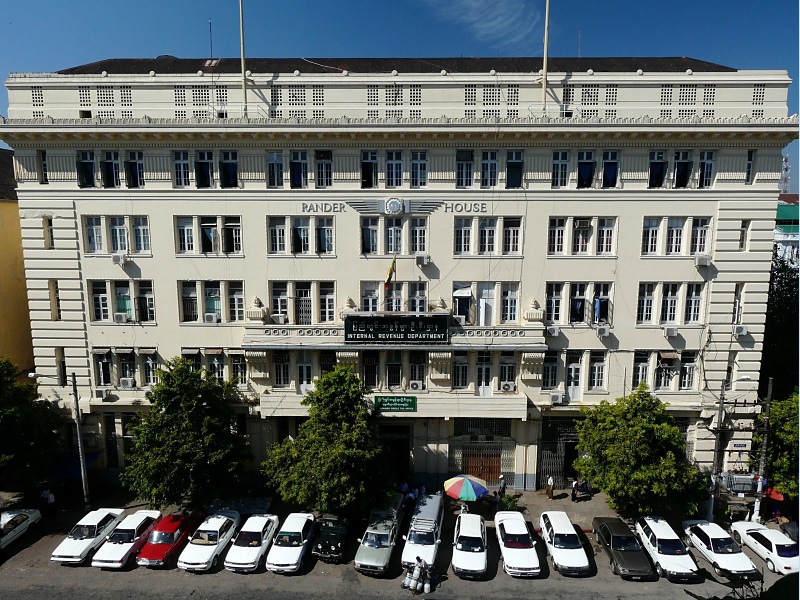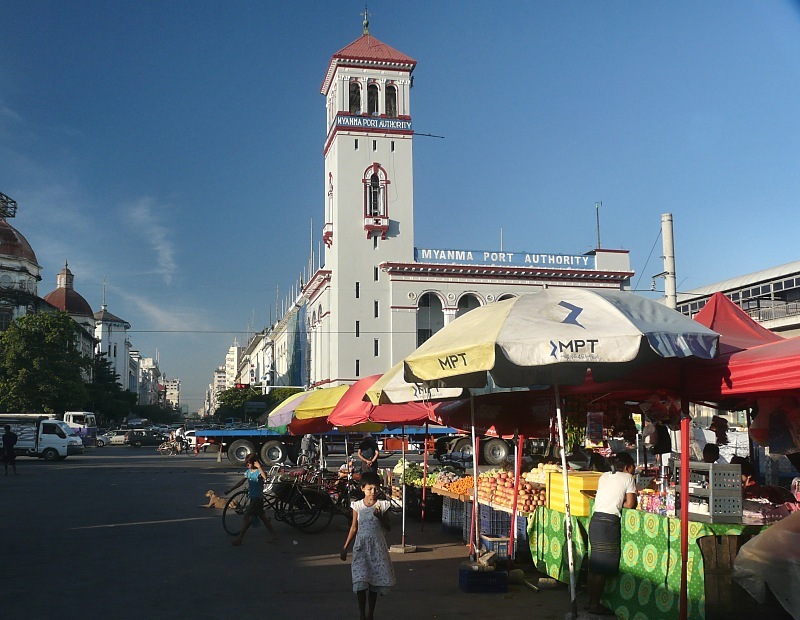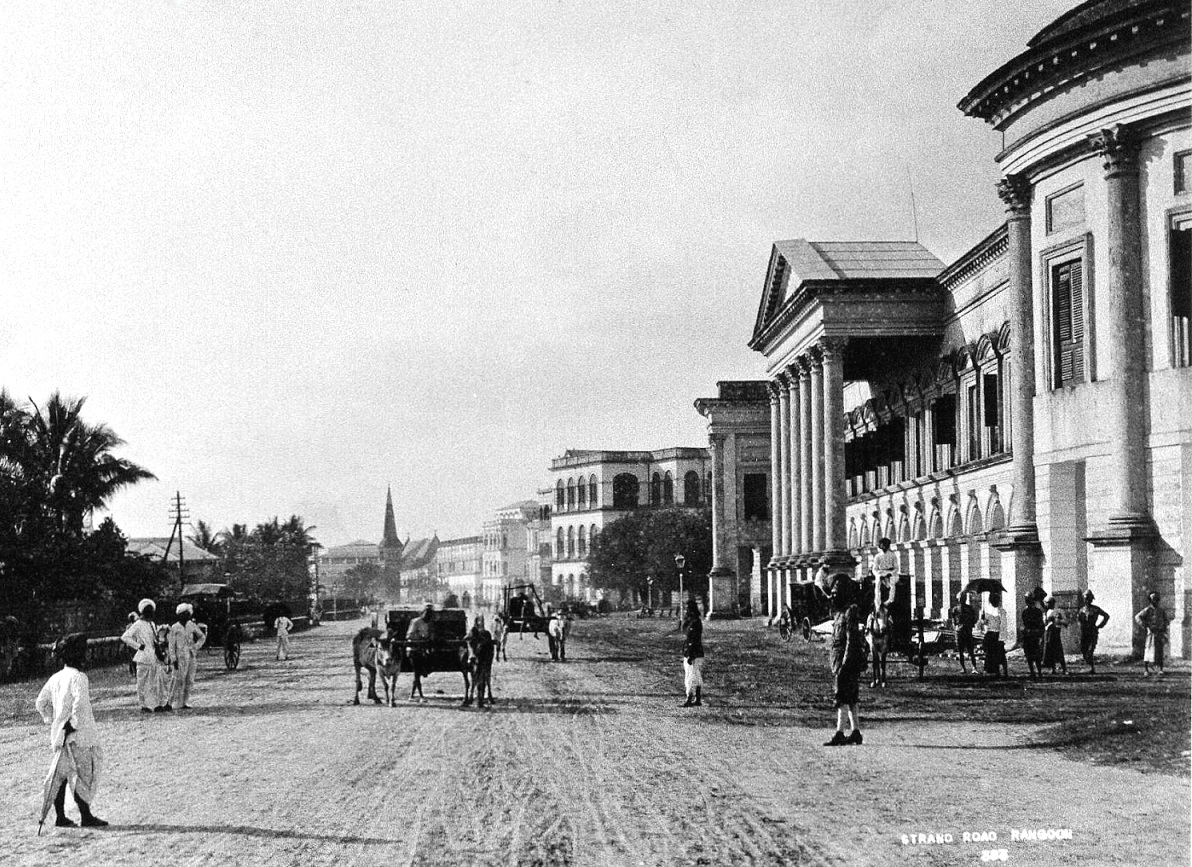|
|
Last update: April 15, 2024 Colonial Yangon, the new Rangoon.Yangon, the new name for Rangoon, is one of the most beautiful preserved colonial cities in Asia; the range of architecturally stunning buildings here is amazing. Downtown Yangon is the most interesting part for tourists, along with the Shwedagon pagoda which is a short taxi ride up the Shwedagon Pagoda Road. Downtown Yangon, around Sule pagoda, was designed in 1853 by the British as a regular grid of streets. Below is a tourist map of the downtown area with its impressive colonial heritage buildings.
The railways in Yangon have a ticket office and a separate advanced ticket office. Train ticket booking for same-day travel can be done at the Central Train station; and there is an advanced train ticket booking office (1-3 days ahead) at Bogyoke Aung San Road just east of the Sule Pagoda Road crossing, opposite the Sakura tower. The advanced booking office is a bit hard to find, because it looks more like a restaurant than an office on the outside.
Yangon Heritage Walk.Yangon is a compact town, so it is quite easy to do a walking tour and admire the colonial buildings. Most of Yangon is walkable, with the exception of only a few busy streets, like Strand road. These few busy streets have traffic lights and pedestrian overpasses and can be crossed safely. You can do a walk on your own; or you can join one of the many guided tours if you prefer a guide.
This heritage walk is about 3 kilometers, and it takes a minimum of an hour if you walk briskly; but count on longer if you want to enjoy it and make some stops. Start your colonial walk at Sule Pagoda, which is the center of Yangon. South-east of the Sule pagoda roundabout is the grassy Mahabandoola Garden Park which was cleaned up in 2015. The tall needle of the Independence Monument of 1948 stands in the middle; flanked on all sides by lion statues.
The remarkable Yangon City Hall (1) is located right on the busy Sule Pagoda square. Because it was built around the 1930's by a Burmese architect, this building is one of the rare colonial buildings which has its own typical Myanmar style. It has changed in the last few years from the traditional yellow to a light mauve pastel color, and is now painted all white. At the next corner is the Rowe & Company building (2); a department store built in 1910 and known as the Harrods of the East. The red and yellow building looked worn-out in 2009; see below.
Since its renovation in 2014 it is the head office of the AYA Bank and it now appears as an elegant wedding cake with beige fondant striping and a prominent clocktower on the corner.
Opposite the AYA bank is the Immanuel Baptist Church, and next to it, a bit down the road, is the official Government of Myanmar travel agent Myanmar Travels and Tours (MTT). MTT provides permits for restricted areas, maps and information.
Monumental PansodanA block further on, at the corner of Pansodan Road, turn south. This stretch of Pansodan is the most beautiful street of Yangon; on the left and right are Rangoon's monumental colonial buildings, as well as some galleries and a few coffee shops. On the first corner is the Telegraph Office (3); this brick Edwardian office block with a classical portico was Rangoon's link to the outside world. Next to it, on the right side, is the more than 110 years old Rangoon High Court building (4). You are looking at the back of the High Court, the main entrance is facing the Maha Bandoola Garden but for some reason this has been closed. Should you wish some refreshments; on the right is Rangoon Tea House, an upmarket, modern, and busy Burmese restaurant which gets good reviews. Next door is Sharky's restaurant. If this is not to your liking you can also walk to the riverside, cross the Strand and have a beer at the large Junior Duck restaurant. The Junior Duck is a Chinese restaurant, which does seem to have dual pricing, so western tourists are charged more. On the corner of Merchant Road is the Rander House (5) - now the Internal Revenue Department. Rander House is an imposing five story building with a rigid window grid and subtle Art Deco features. It was built in 1932 by Indian traders who had migrated to Burma from Rander, a town close to Surat in Gujarat.
Opposite Rander House is the Lokanat building, when it was built in 1906 it was the Sofaer & Co. building (6). A large part of the four-story structure is in a deplorable state, and in need of a thorough restoration. The exception is Gekko, a Japanese restaurant on the corner of the Lokanat building. On the first floor is the famous Lokanat Gallery. Isaac and Meyer Sofaer were Baghdad-born Jews, and educated in Rangoon. Next on the left side is a rather nondescript building which used to be the Grindlays Bank; and is nowadays occupied by the Myanmar Agricultural Bank. At Pansodan Street nr. 22-24 is the location of the Yangon Heritage Trust (HT), on the second floor. They are very active with preserving the historic buildings of Yangon. The waiting room has a fine display of historical photography.
At the end of Pansodan Road on the corner with Strand is the Myanma Port Authority building (10) built in 1920. Opposite the Port Authority is the old Accountant General's Office (9), a rather dilapidated building which is now in use as office for the Yangon Division Court. The Accountant General was responsible for collecting all revenue in Burma, which for a large part was from teakwood. You can have a look into the building, but entry is not allowed.
The Strand Stroll.On the strand, we can spot the New Law Courts building (7) to the west. The imposing New Law Courts building was completed in 1931, after the old Law Courts building was destroyed by the 1930 Bago earthquake.
After a complete renovation of the old, large New Law Courts building, the Rosewood Yangon hotel opened here in 2020. During the second world war, the Japanese transformed the building into the headquarters of their much-feared Kempeitai, or secret police. It also housed the District Court and the Police court in past years. Next to the Law Courts building is the Custom House (8), one of the oldest masonry structures in Yangon; built in 1916. Now you can cross by footbridge over the busy Strand Road, and walk through the small market. If you walk a bit to the east, past the Chinese Junior Duck restaurant, you can see the ferry boat landing. The small ferry boats from the Dala village on the opposite side of the Yangon River land here, the large Dala ferry lands somewhere else.
Unfortunately, Yangon does not have a riverside boulevard, and there are not many places to see the Yangon River. One has to cross back over the footbridge to continue this walking route. On Strand Road walk eastwards until you reach the Post Office; on this stretch there are many colonial buildings, like the Bombay Burmah Trading Corporation (11), set up by the Wallace Brothers from Edinburgh. Now this modest building is the office of Myanmar National Airways (MNA). In the mid-1850s the Wallace brothers set up a business in Rangoon, shipping tea to Bombay. In 1863 the business was floated as The Bombay Burmah Trading Corporation, and by the 1870's it was a leading producer of teak in Burma and Siam. They started the large-scale deforestation that has continued since then. Nowadays there are very few mature teak trees left in the forests - most teak trees grow in teak plantations. Strolling along the busy Strand Road we next find the high-end and very famous Strand Hotel (12). The Strand Café offers their renowned High tea, which is a traditional tea and pastries experience. Further on is the British Embassy (13), the former J&F Shipping Company, and at the next corner the marvelous maroon General Post Office (14), the former Bulloch Brothers & Co.
The Secretariat.At the corner of the Central Post Office turn left into Bo Aung Kyaw Street. Along this stretch are only residential buildings, mostly from the colonial era. On Maha Bandula Road is the entrance to the grand and impressive Secretariat (15), built around 1900, which occupies an entire city block. This is where general Aung San (Bogyoke Aung San) was assassinated during a cabinet meeting. The Secretariat was a government office, and used to house the administration of Burma, which was part of British India in colonial times. When the new capital of Myanmar was established at Naypyidaw in 2005, all government departments were transferred there, and the Secretariat has been left unoccupied since then. The huge Victorian building complex (the 400.000 square foot building is two-thirds the size of the Louvre) has been closed for many years and could only be photographed from behind the fence. In 2012, a plan to turn it into a museum failed; another project to turn it into a hotel and a cultural centre failed as well. Finally, the building was renovated during 2018 and 2019. The Secretariat is nowadays open to visitors from 9 am to 4:30 pm daily. Visitors are allowed to observe the ground and first floors free of charge. If you want to explore other restricted areas, they will have to pay a fee, which is 3.000 Kyat for locals, and 10 dollars (15.000 Kyat) for foreigners.
Now you can head westwards on Maha Bandula Road, a busy street with lots of shops. You can also go up north, past St. Pauls High School, now renamed Basic Education High School (BEHS), and have a look at St. Mary's Cathedral (the Immaculate Conception Cathedral), the largest cathedral in Burma. Joseph Cuypers, a famous Dutch architect who designed a lot of churches in the Netherlands, designed this colourful cathedral. It opens in the morning till 12, and after 3pm till 4:30 in the afternoon. After a look into the cathedral, go west on Anawrahta Road and walk back to Sule Pagoda Road. Back on Sule Pagoda Road you can have a good cappuccino with a croissant or other delightful pastry at the Parisian Cake and Coffee. This bakery & cafe is on upper Sule Pagoda Road opposite the historic central Kyauktada fire station (16) with its 100-foot fire-tower. Nowadays, the fire-tower seems rather small, compared to the large new buildings on Sule Pagoda Road. The fire station is still fully operational. And this is the end of my Yangon Heritage tour; I hope you have enjoyed it. Send me a quick email if you did!
Bogyoke Aung San marketThe Bogyoke Aung San market was built in 1927 and originally known as Scott's market. Today, the market has jewelers, art galleries, clothing shops, antiques and local handicrafts. Opposite the market are some small bookshops, which sometimes have english books. Bogyoke market has a small railroad overpass lane to the north of it, but this is closed when the market closes, at 5pm sharp. The market is also closed on Monday. The overpass leads to Bo Yar Nyunt Road, which has quite a few restaurants and bars. Walking westwards on Bogyoke Road, at the next corner is the Holy Trinity Cathedral (1886). Walk a bit further along Bogyoke Road and you will see the Rangoon General Hospital, built in 1911, which can be visited, but photographs inside are not permitted.
Other tours through Yangon city.Free Yangon Walks (freeyangonwalks.com) seems to have scaled down in 2017 because of a lack of volunteers; they don't have free walks anymore; only paid walking tours. There are also other tours; like the Heritage Building Walking Tour or the George Orwell Literary walking tour (3 hours). Sa Ba Street Food Tours is a new street food tour through Yangon which gets very good reviews: sabastreetfoodtours.com More on Yangon colonial architecture:
Book shops on Pansodan Street.For many years Pansodan Street was the home of second-hand booksellers, but in 2017 most of them had to move to Thein Phyu Road (between Bandoola and Anawrahta Road); just east of the Secretariat. The new "Saturday-Sunday Book Street" is only open on weekends. There are nowadays still a few booksellers on Pansodan. A new shop is the Book Plaza, on the 5th floor of Than Zay Market, Lanmadaw Street, Yangon; open daily from 9am to 7pm. Only one of the shops in the Book Plaza has English language books. The more interesting shop is in the far north east corner of the plaza, which has interesting second hand books, dating back to the fifties, including poetry, guide books, etc. More on Book Street and Book Plaza: www.mmtimes.com
Yangon travel links
| ||||||||||||||||||||||||||||||||||||||||||||||||||||||
|
About the author: aboutme.htm
|












